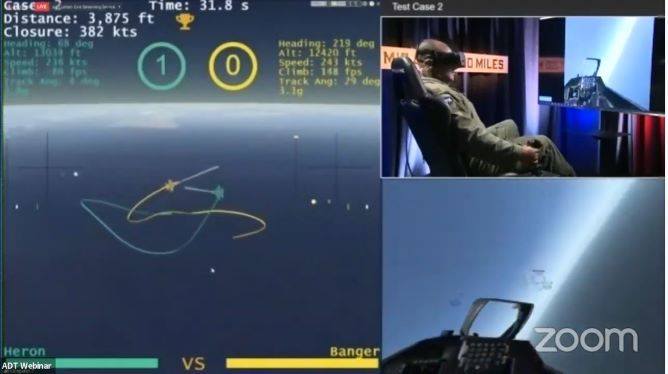In August this year, the Defense Advanced Research Projects Agency (DARPA) kicked off a virtual showdown between eight research teams from around the United States. The teams pitted their artificial intelligence (AI) algorithms against each other in a combat maneuver demonstration, formally known as the 2020 AlphaDogfight Trials.
The event took place over three days and culminated in a showdown between the winning AI team and a top-tier human pilot steering his virtual plane through a virtual reality headset. The AI algorithm, created by Heron Systems, was victorious over the human pilot as well. Georgia Tech Research Institute (GTRI) placed sixth among all eight AI teams, which also included Aura Fight Sciences, EpiSys Science, Lockheed Martin, Perspecta Labs, PhysicsAI, and SoarTech.
GTRI research engineer Eric Squires was one of the leads in creating the AI for GTRI’s AlphaDogfight project. He shares some lessons learned and interesting insights from the event.
Creating a Reactive AI
Virtual reality is a great place to test the AI, and it gives us some insight into how it might behave in real life. To create their AI, GTRI researchers interviewed fighter pilots to learn about their behaviors.
“Translating what’s in their minds — what’s been developed over years [and] time — into the mathematical equations that we need to do good AI research was an interesting part of this program,” Squires said.
In addition to translating real life experience, GTRI researchers trained the AI to favor certain behaviors by rewarding it when it did something right, which is very similar to how you would train a pet dog.
What was surprising was that the AI began to learn behaviors and make decisions that the researchers had not taught it. This was a pleasant surprise to Squires, and it became a major takeaway from this project.
“When we started this project, we really didn’t know what to expect in terms of what the AI would ultimately learn, so we thought it would be quite a challenge in order to create an AI that could really do some of these aggressive maneuvers,” he said.
How the Experience Might be Different in Real Life
Virtual reality provided a test environment for the AI algorithms; however, in the real world, there are always other variables at play.
“What we basically discovered there was that it was a very good environment for testing out ideas and validating that we are able to create AI that can exploit an environment and create behaviors that are very similar to what we would see in real life,” Squires said. “But there is still a gap between our simulated environment and live flight that future work will seek to address.”
While interviewing the fighter pilots, GTRI researchers discovered what was critical for winning a dogfight. That includes being able to get behind your opponent and maintain your position.
However, the Heron Systems AI won by facing its opponents and taking shots — a difficult maneuver to execute and one not typically used by fighter pilots. Squires says this speaks to the nuanced capability of the AI and how it learned on its own.
One thing to consider is that fighter pilots don’t typically train in virtual reality, so the outcome may have been different if an AI-controlled plane had entered their realm.

Worlds Collide
Overall, the 2020 AlphaDogfight Trials was a beneficial event — bringing together the fighter pilot and AI communities. The trials allowed researchers to test their algorithms and get a sense for how their creations might be useful in the real world. Moreover, Squires said, the event showcased what GTRI and the other teams had to offer.
“I think that one thing that came out to me during the competition is that the United States has a really strong set of artificial intelligence researchers,” Squires said. “They had eight teams that were able to create an artificial intelligence system that looked very similar to what a human pilot would do, and I that’s a real testament to the capabilities that have been developed over a number of years.”
Distribution Statement "A" (Approved for Public Release, Distribution Unlimited)
Feature photo is a screenshot from GTRI's simulation software, SCRIMMAGE.
Writer: Kaitlyn Lewis





